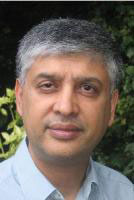 Professor Inderjeet Dokal
Professor Inderjeet Dokal
Barts and The London School of Medicine and Dentistry
Queen Mary University of London
Barts Health
London, UK
2013 - Telomeres and telomere biology in ageing
Telomeres are repetitive DNA sequences (TTAGGG) that protect chromosome ends (from cellular exonucleases and non-homologous end joining) and maintain integrity of chromosomal DNA. They serve as mitotic clocks that keep track of the number of cell divisions during a cell’s lifetime. Telomere maintenance is a complicated process and is crucially dependent on the enzyme telomerase; a complex which has two core components (TERT and TERC) and a number of co-factors (including dyskerin, NOP10 and NHP2). In normal somatic cells, such as skin fibroblasts, telomerase is not normally expressed and telomere loss occurs at each cell division. It is estimated that as much as 200 base pairs of genomic DNA is lost with each round of DNA replication. When telomeres become critically short, cells enter irreversible growth arrest state called replicative senescence or aging. In some cells (e.g. stem cells, germ cells), in which longevity is important, telomerase is expressed and telomere length is maintained.
There is considerable evidence from human studies, animal models and human disease states that telomere length could be a biomarker of biological aging. For example, patients with inherited diseases such as dyskeratosis congenita (DC) and related syndromes are characterized by having very short telomeres (due to inherited defects in telomerase, shelterin or other components of the telomere maintenance machinery) and features of premature ageing (e.g. premature greying, dental loss and early onset of cancer). Telomere length measurements, especially measurements of the shortest telomeres, provide a molecular determinant about health. It has been observed that telomere length of blood cells decreases
as human’s age. Furthermore many environmental factors (such as smoking, excessive drinking) can increase the rate of telomere shortening. Telomere length measurement can therefore provide important information on an individual’s overall health.
There are several different assays for telomere length measurement; those that are able to provide information on the shortest telomeres are believed to correlate best with the ability of human cells to proliferate and replenish tissues. Telomere length measurement thus represents a useful biomarker of “biological ageing” and has potential in monitoring aspects of human health and disease.